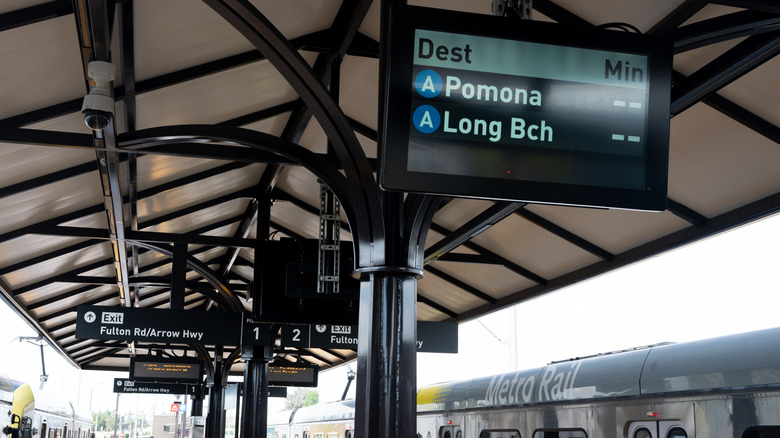Earth's Longest Light Rail Line Is About To Get Even Longer
America is a vast country that relies heavily on cars and an intricate interstate system. When we think of rail transit, many of us often think of Europe, but the longest light rail line in the world is actually here in the U.S., and it's only getting longer.
Spanning 48.5 miles, LA Metro's A Line takes the crown for the longest light rail line, and a new expansion is adding 9.1 miles to that. The A Line, which opened in 1990 and is the oldest in the LA Metro system, was originally called the Blue Line. It runs from Long Beach to the newest station in Pomona, with a major connection in downtown Los Angeles. The Pomona North station recently opened along with three other stops as part of the Foothill Gold Line expansion project. Two additional stations are expected to open in the future.
Light rail systems are rapid transit that typically have a lower capacity than heavier rail systems, such as Amtrak. They are often used in cities and originate from streetcar systems. They are called "light" not because the trains weigh less but because they carry fewer passengers than other types of rail lines. They typically operate above ground, at what's known as "at-grade," meaning they can operate on streets or even in highway medians. The second-longest light rail line isn't in the U.S., but in Belgium. Known as the Coast Tram, it's 41.6 miles long and offers 68 stops along Belgium's coast.
The Foothill Gold Line Expansion
If you don't use the LA Metro light rail system or take the A Line regularly, you may not have heard of the Foothill Gold Line Expansion, which is adding additional stations east of LA. The expansion began in 2020, with the first phase, which includes the four new stations, costing a whopping $1.5 billion. This section of the expansion was funded with a half-cent sales tax approved by county voters in 2016, along with residual funds and almost $300 million in grant funds. The final 3.3-mile stretch connecting Pomona to Montclair has been partially funded with state grants and will be completed as two separate projects, with some additional funding still required.
The new 9.1-mile addition currently takes riders to Glendora, San Dimas, La Verne, and Pomona, and will add Claremont and Montclair in upcoming years. The A Line is in service from 4 a.m. until midnight, with trains every eight minutes. Tickets start at $1.75, with no surge pricing during peak hours, and LA Metro even offers discounts for students and seniors. Each of the new stations offers several hundred parking spaces, along with charging stations for EVs, bike parking, and rideshare drop-off zones. The stations are also serviced by several local bus lines.
Most people won't ride the entirety of the A Line, which would take a little over two hours. Driving the same distance in non-rush hour traffic only takes about an hour. But the new stations offer easier access to suburban LA and will hopefully keep some commuters off LA's very congested roadways.

